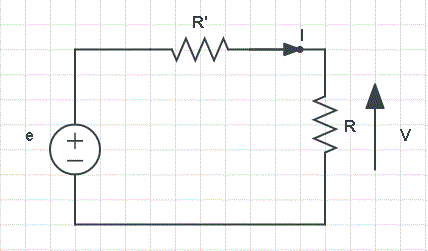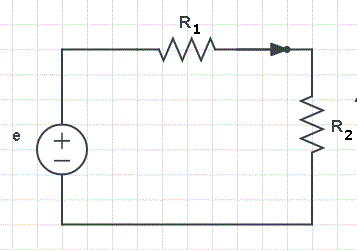
Ohm's law states that the voltage \( V \) across a conductor of resistance \( R \) is proportional to the current \( I \) passing through the resistor (see circuit below). The relationship is written as: \[ V = R I \]

Example 1
Find the current \( I \) through a resistor of resistance \( R = 2 \, \Omega \) if the voltage across the resistor is 6 V.
Solution to Example 1
Substitute \( R \) by 2 and \( V \) by 6 in Ohm's law \( V = R I \).
\[ 6 = 2 I \]
Solve for \( I \):
\[ I = \frac{6}{2} = 3 \, \text{A} \]
Example 2
In the circuit below resistors \( R_1 \) and \( R_2 \) are in series and have resistances of 5 \( \Omega \) and 10 \( \Omega \), respectively. The voltage across resistor \( R_1 \) is equal to 4 V. Find the current passing through resistor \( R_2 \) and the voltage across the same resistor.

Solution to Example 2
We use Ohm's law \( V = R I \) to find the current \( I_1 \) passing through \( R_1 \).
\[ 4 = 5 I_1 \]
Solve for \( I_1 \):
\[ I_1 = \frac{4}{5} = 0.8 \, \text{A} \]
The two resistors are in series and therefore the same current passes through them. Hence the current \( I_2 \) through \( R_2 \) is equal to 0.8 A.
We now use Ohm's law to find the voltage \( V_2 \) across resistor \( R_2 \).
\[ V_2 = R_2 I_2 = 10 \times 0.8 = 8 \, \text{V} \]
Example 3
In the circuit below resistors \( R_1 \) and \( R_2 \) are in parallel and have resistances of 8 \( \Omega \) and 4 \( \Omega \), respectively. The current passing through \( R_1 \) is 0.2 A. Find the voltage across resistor \( R_2 \) and the current passing through the same resistor.

Use Ohm's law \( V = R I \) to find the voltage \( V_1 \) across resistor \( R_1 \).
\[ V_1 = 8 \times 0.2 = 1.6 \, \text{V} \]
The voltage across resistor \( R_1 \) and the voltage across resistor \( R_2 \) are the same because \( R_1 \) and \( R_2 \) are in parallel.
We now use Ohm's law to find current \( I_2 \) passing through resistor \( R_2 \).
\[ 1.6 = 4 I_2 \]
Solve for \( I_2 \):
\[ I_2 = \frac{1.6}{4} = 0.4 \, \text{A} \]
Example 4
The current passing through a resistor in a circuit is 0.01 A when the voltage across the same resistor is 5 V. What current passes through this resistor when the voltage across it is 7.5 V?
Solution to Example 4
Use Ohm's law \( V = R I \) to find the resistor \( R \) in this circuit. \[ 5 = R \times 0.01 \] Solve for \( R \): \[ R = \frac{5}{0.01} = 500 \, \Omega \] We now use Ohm's law \( V = R I \) and the value of \( R \) to find the current when the voltage is 7.5. \[ 7.5 = 500 \; I \] Solve for \( I \): \[ I = \frac{7.5}{500} = 0.015 \, \text{A} \]
Example 5
The graph below represents the voltage \( V \) across a resistor against the current \( I \) passing through the same resistor. What is the resistance of the resistor in the circuit?

Ohm's law \( V = R I \) is similar to the equation of lines of the form \( y = mx \), where \( m \) is the slope. Hence, in the graph of \( V \) against \( I \), the slope of the graph is the resistance.
We need two points from the graph to find the slope. Points \( (0,0) \) and \( (1,10) \) form the graph, and we can use them to find the slope and hence the resistor \( R \).
\[ R = \frac{10 - 0}{1 - 0} = 10 \, \Omega \]